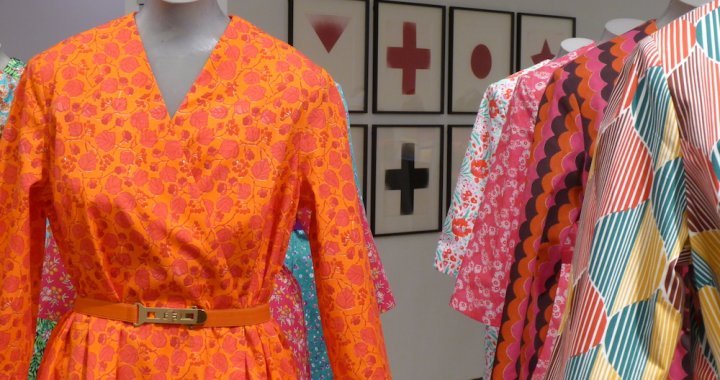
In search of our own uniqueness
An interview with curator of the Tallinn exhibition ‘Sots Art and Fashion: Conceptual Clothes from Eastern Europe’ Liisa Kaljula
20/05/2019
The exhibition Sots Art and Fashion: Conceptual Clothes from Eastern Europe currently on view at the KUMU art museum in Tallinn (through August 4) unexpectedly brings together post-Soviet visual art and contemporary conceptual fashion. Classic examples of Estonian Pop Art and conceptualism, as well as Moscow Sots Art rub shoulders with Eastern European avant-garde fashion, both photographic records of Perestroika-era experiments and contemporary collections. For instance, ironically elegant assemblages of the famous Soviet ‘cheerful prints’ are juxtaposed with the 77 Chintzes collection by Marit Ilison, created for this exhibition based on archive materials of the Krenholm Manufacturing Company, where the archaeology of Soviet culture is accompanied by a certain nostalgic note. Nevertheless, the synthesis of this extremely diverse material and interpretations of the Soviet legacy can be described as convincing: not only does the exhibition, rich in visual dialogues, explore the subject matter as defined by the title of the show, but it also tackles the more general question of the uniqueness of Eastern European art. Curator of the exhibition Liisa Kaljula spoke to Arterritory about the ideas behind the exhibition.

Assemblage by Andres Tolts and 77 Chintzes installation by Marit Ilison
Your exhibition cleverly combines two approaches to interpretation of the Soviet culture ‒ by contemporaries in their own time and by artists of the younger generation at a much later point ‒ and, through this, also two perspectives: the insider’s view and a retrospective one. Alongside these vantage points, you also elegantly balance between different areas ‒ historical conceptual art and contemporary fashion. Could you tell us about the points of intersection that made this juxtaposition possible?
That is what curator’s job actually is ‒ it is creating new juxtapositions. If for an academic researcher this kind of bold juxtaposing is, as a rule, unacceptable, in the case of a curator it is, I believe, an approach that is quite apposite. It is both the distinctive feature and potential of exhibition as a medium. Paradoxically, it was my research that served as an impulse for this particular juxtaposition. While studying historical Sots Art at various libraries, I learnt that a number of Russian researchers consider the circulation of Soviet-era symbols in the art of fashion and set design of the late 1980s rock concerts as an extension of the 1970s Moscow-based Sots Art. And I thought that this idea would lend itself rather well to a genealogical type of exhibition. Post-Soviet aesthetics joined the historical Sots Art fashion quite naturally, since it was necessary to compile an exhibition-size volume of material united by its origins and the initial impulse: Eastern European artists, tired of the studious following of global trends, are keen to use local materials and tap into local subject matters ‒ even if the latter are somewhat stigmatised, as is often the case with symbols of the Soviet era in Eastern Europe. Despite the lack of historical links, I believe that it is this regionality that is the main common feature of Sots Art and post-Soviet aesthetics. Apart from that, the exhibits are also united by the fact that we are dealing not so much with practical clothing created for everyday use here but rather with conceptual fashion art which, in addition, loves using text in its designs. Hence the somewhat wordy and quite clumsy subtitle of the exhibition, Conceptual Clothes from Eastern Europe.
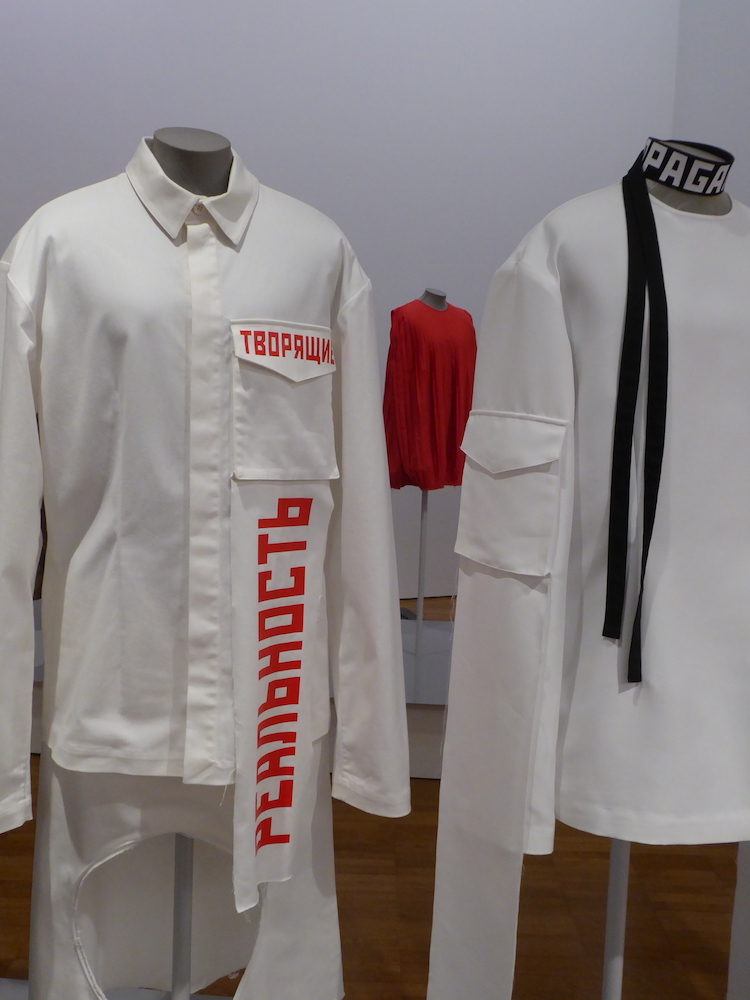
Collection Propaganda about Propaganda by Yulia Yefimchuk. 2017
What are the differences between these approaches that you could name? Could we say that the conceptual art of the time did not enjoy this distance from the Soviet reality that seems to evoke nostalgia, a tendency to exoticise etc. in contemporary artists? Or perhaps back then artists were also quite good at distancing themselves and finding situations that could be aestheticized, not just criticised?
That’s an excellent question. Historical Sots Art is, of course, a deconstructivist cultural phenomenon that aimed at disrupting the almighty Soviet visual discourse even back then, at a time when the Soviet Union was still quite viable and annoyed artists with its ways of limiting creative freedom. For representatives of post-Soviet aesthetics, the Soviet-era experience is predominantly limited to childhood memories. Therefore, these two artistic movements do have a very different approach to the symbolic and material legacy of the Soviet era. Nevertheless, Boris Groys noted in one of his final interviews that Sots Art gradually underwent a very interesting transformation. If at the time of its formation Sots Art was openly cynical and deconstructivist regarding the Soviet regime, eventually, in the eyes of people interested in history, it became an art movement that recorded the Soviet visual culture and even evoked nostalgia, as if saying that this was a special time that would never come back. This balancing act between irony and nostalgia was what interested me most during the preparation stage of the exhibition. You might think that Marit Ilison's army of smock-clad women or jumpsuits for cosmonauts by Sonja Litichevskaya are designed in ironic key, but at the same time their message is also quite warm, nostalgic and romantic. But I do agree that our current distance in time obviously made possible this unprecedented exoticisation of the Soviet era in post-Soviet countries.
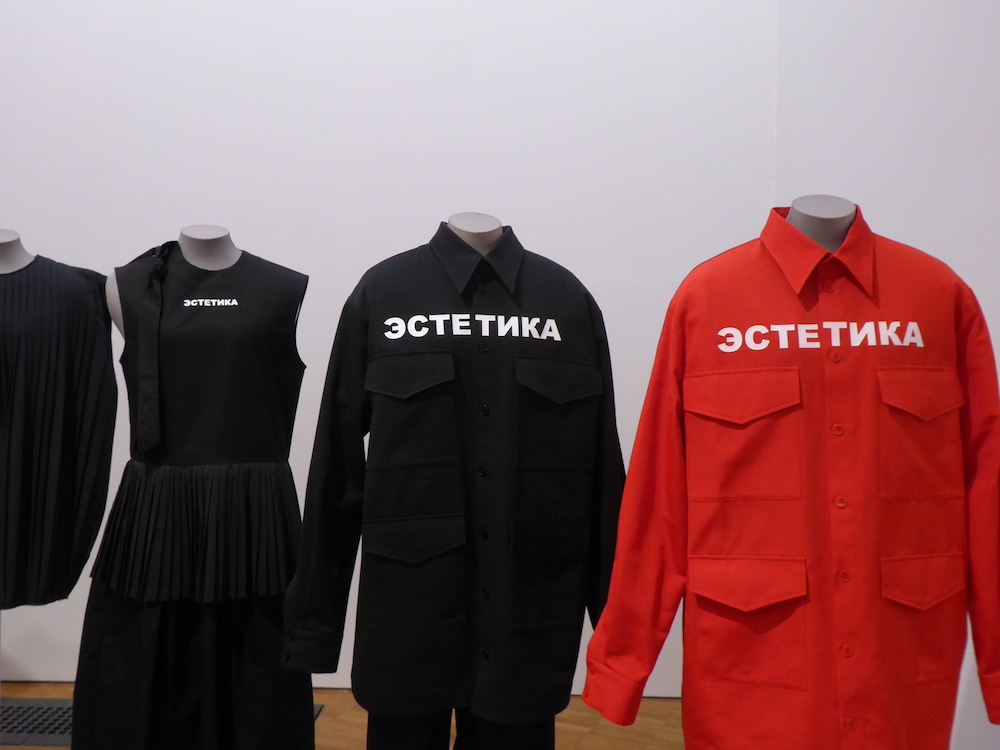
Collection Technical Aesthetics by Yulia Yefimchuk. 2018
Estonian art can present its own answer to this sub-product of the Moscow conceptualism, Sots Art, namely, the so-called Union Pop (liit-pop). If I’m not mistaken, the strategies of Union Pop were formed even before the birth of Sots Art? Do you view Union Pop as a separate phenomenon or as part of the Sots Art movement, translating this local phenomenon into the language of international art history?
It is a matter of name, and art historians have always been very fond of this naming game. In the context of this game, we could say that the art movement founded in the late 1960s by the members of the SOUP ’69 group was Union Pop, which was radically different from Sots Art, formed in the early 1970s in Moscow by Erik Bulatov or by Komar and Melamid. But we can also do the opposite by juxtaposing them ‒ if we want to write a comparative history of Eastern Europe. Writing this kind of history that would only make sense to people in Estonia does no longer interest me personally very much. Furthermore, I believe that Eastern Europe is in dire need of a new art history, one that would operate with notions developed by local authors, not borrowed from Western art history. For this reason, I personally prefer to view the early oeuvre of Andres Tolts and Leonhard Lapin as original Estonian Sots Art rather than yet another watered-down derivative of Western Pop Art, made in the culturally deprived and constantly assistance-thirsty Eastern Europe. At the end of the day, however, writing various histories of art is a creative discipline of the humanities that lends itself to various interpretations, and it is the best-argued or most elegantly written studies that enjoy the greatest success. But it is actually a historical fact that Andres Tolt made his first ironical-deconstructivist collages out of illustrations to the Ogonyok Magazine in 1968 but Erik Bulatov painted his Horizon, considered as the inaugural Sots Art work, in 1971‒1972.
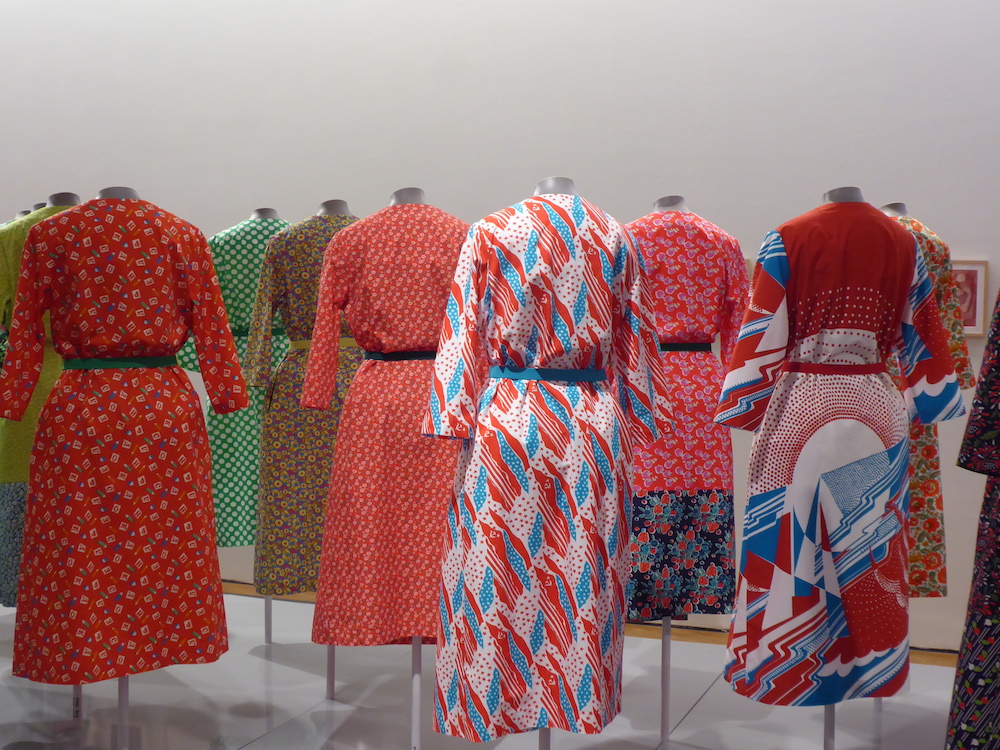
Installation 77 Chintzes by Marit Ilison. 2019
At what ratio are the old and the new represented at the exhibition? Is Sots Art an equal participant of the show or does it rather provide the conceptual framework for reflections on a more contemporary phenomenon?
Those viewers who are more sensitive regarding power relations and hierarchies at exhibitions may find that the new is prevailing over the old and that young artists dominate over the older generation. On the one hand, it is a deliberate choice determined by the fact that Sots Art is mostly represented at the show by older men and the post-Soviet aesthetics ‒ mostly by young women. And this time I wanted to stage the exhibition so that the established and self-fulfilled older male artists support the female artists who have only recently emerged on the art scene and are only on their way to self-fulfilment. That is why all the dummies in the centre of the rooms wear contemporary garments while Sots Art works dating from the 1970s and 1980s serve as a backdrop. Many exhibition-goers may find that the world-renowned conceptualists Komar and Melamid are overshadowed at this particular show by the fashion designer Marit Ilison. To answer this criticism, I admit that it was a deliberate decision because I would love to see something like this happening in the Estonian society: privileged groups could sometimes make way for the less successful ones. Perhaps it could lessen the deluge of various radical parties of protest because feelings of happiness and satisfaction with life would be more evenly distributed among the population.
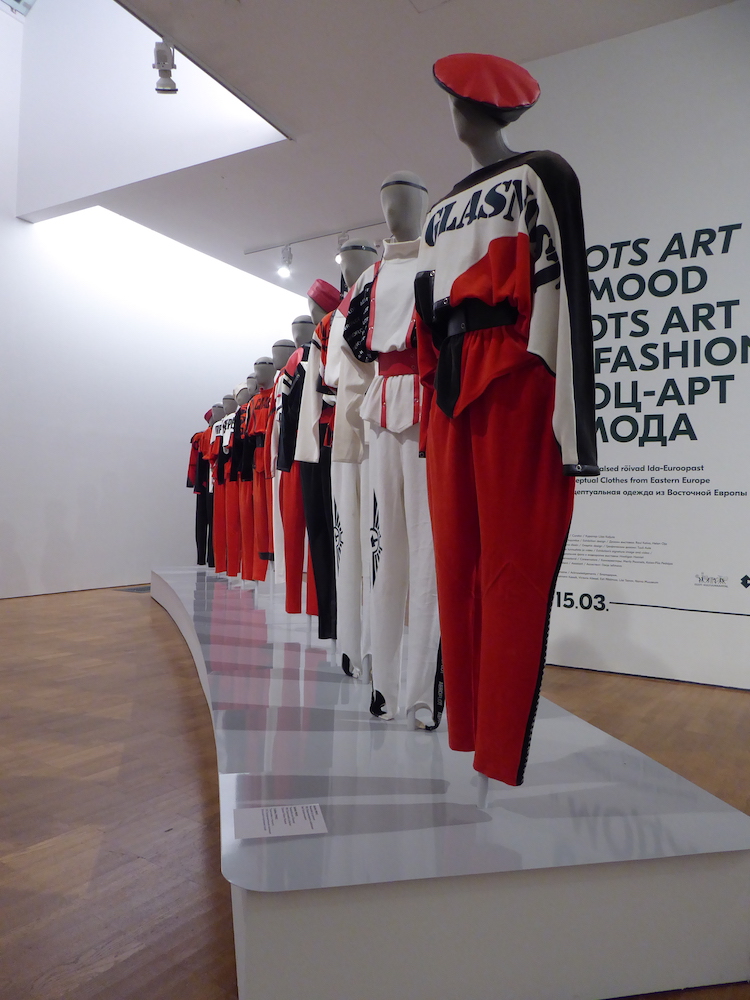
Conceptual collection Perestroika and Glasnost by Saima Priks. 1987
You have invited contemporary fashion designers from various countries and cities to take part at the exhibition ‒ from Tallinn, Moscow, Kiev and Berlin. What was the basis for the selection? Did the particular character of works by the Estonian representatives, Marit Ilison and Saima Priks, play a role here?
I was motivated by various aspects; on the one hand, it was the geographical diversity, on the other ‒ the necessity to highlight the most significant fashion centres of Eastern Europe. On the one hand ‒ my intent to show the best and most interesting part of the post-Soviet aesthetics, on the other ‒ the practical side of transporting the collections to Tallinn. Honestly speaking, it is easier to bring here exhibits from the Old Europe than from an Eastern European country under martial law or a country to which EU sanctions apply. What I wanted to say was ‒ should I try to list the reasons why Eastern European art is unable to hold its head high, I could go on and on. And Eastern Europe has partly itself to blame for its lack of regional solidarity, for the booming bureaucracy and blind Western-centrism. Nevertheless, with the help of the respective Estonian embassies we finally succeeded in overcoming these obstacles and bringing to KUMU exhibits from Moscow and Kiev. But it is true: my choice was also determined by the character of works by the Estonian artists, because an exhibition has to be an integral whole. Of course, I was looking for good juxtapositions that would help showcase the art of Marit Ilison and Saima Priks. For instance, I have long been thinking that the work of Marit Ilison in Estonia is in need of contextualisation, of seeking out like-minded artists from former socialist countries, and only then will we be able to fully recognise this thing that she has been consistently doing for the last ten years.

Conceptual collection Perestroika and Glastnost by Saima Priks. 1987
You noted that a dialogue with the Soviet legacy could be described as an artistic method that unites the whole region. What are the common features that allow expanding the focus to include the whole Eastern Europe and what is unique for Estonia?
Yes, I see in this a potential for a cultural integration between the countries of Eastern Europe. I believe that our experience of living under socialism remains the main feature that unites us. A resident of Estonia can try in vain to explain to a Western European what a fufaika (a padded jacket) or a calico print smock is until the cows come home. But when we meet another person from Eastern Europe, the mutual understanding is immediate: in a sense, we simply speak the same language, even if we would rather not. There are theorists, like the recently deceased Polish art historian Piotr Piotrowski, who claim that Eastern Europe as a formation was born out of the socialist experience that was forced on us. So – yes, I definitely do see in the art of former socialist countries a creative potential that is linked to the past that we all share. For instance, our inclination for black humour or our peculiar understanding of surrealism: Eastern Bloc artists had no need to search for inspiration in their dreams or drugs; the very life under socialism was surreal. That is the subject of Komar and Melamid’s ‘Super Objects ‒ Super Comfort for Super People’, on view at our exhibition. As for the differences, I think that the old-school Soviet clichés can actually be of some help here: among the Soviet nations, Estonian art was generally considered the most ‘Nordic’ and stylistically laconic ‒ more intellectual than emotional. If we compare, for instance, the early Sots Art pieces by Komar and Melamid and the early oeuvre of Leonhard Lapin, both exploiting the Soviet symbols, this tired cliché actually works.
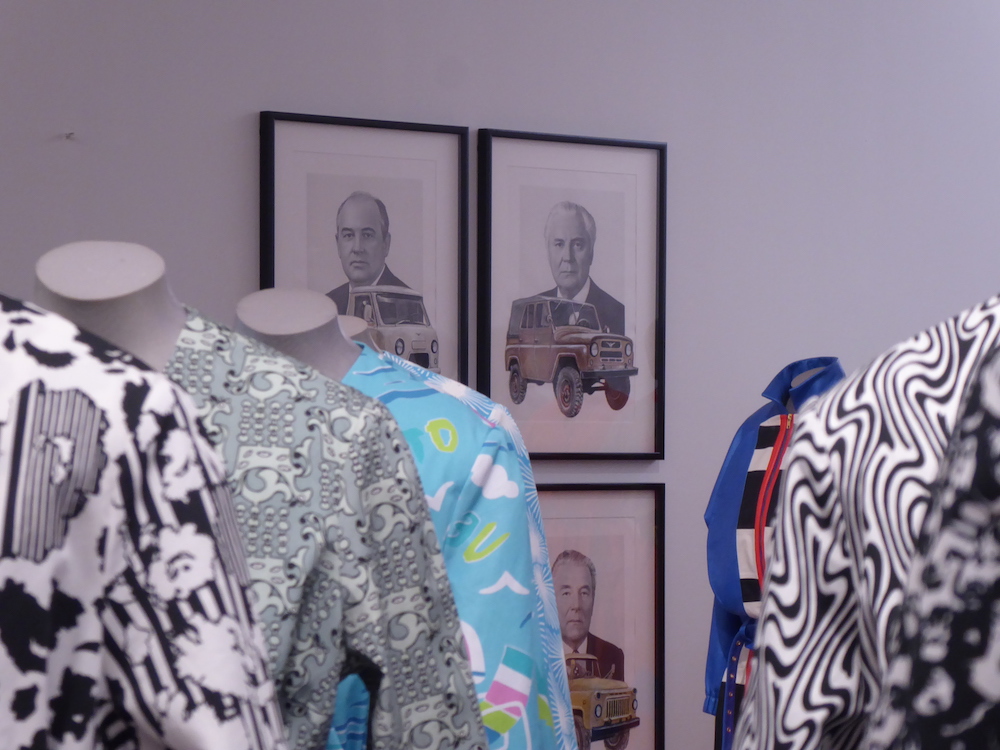
Politburo series by Raul Rajangu and 77 Chintzes installation by Marit Ilison
In one of your texts you refer to this show as the ‘first museum exhibition of post-Soviet aesthetics’. Do you mean the Estonian context or are we truly dealing here with the first initiative of this kind internationally ‒ as far as you know?
It was a deliberate provocation on my part. To the best of my knowledge, there have been no other museum exhibitions of post-Soviet aesthetics to date, but I would be happy to hear from anyone possessing different information. I can definitely say that in the birthplace of post-Soviet aesthetics, that is, in Eastern Europe, this phenomenon has not been explored in a museum context. I thought at length about it after visiting the Fabric of Felicity exhibition at the Garage museum of contemporary art in Moscow last autumn ‒ basically, a show of conceptual fashion featuring next to no Eastern European artists. At the same time, I believe that Eastern Europe is a genuine Mecca of conceptual fashion and would have a lot to offer to the rest of the world ‒ if only we somehow taught ourselves to recognise the value and uniqueness of our own culture!